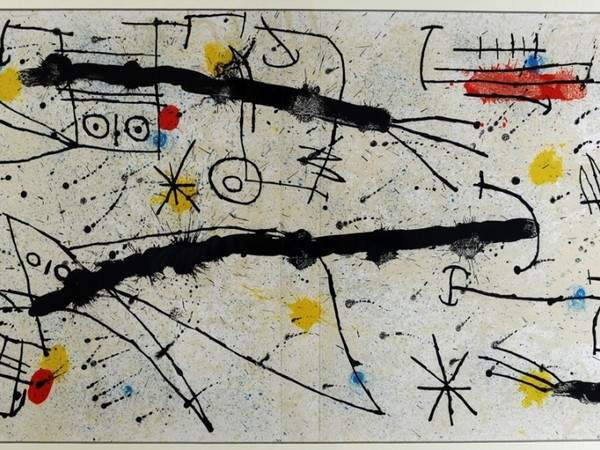Joan Miró's colors come to Puglia. His lithographs on display at three venues
Joan Miró ’s colors and emotions in the wild come to three cities in Puglia, namely Gioia del Colle, Casamassima and Turi, for the exhibition Miró. Quelques Fleurs pour des Amis, from Dec. 22, 2019 to April 26, 2020, as part of the Operation Works Out of Context. The exhibition can be visited at Palazzo Monacelle in Casamassima, Palazzo San Domenico in Gioia del Colle , and Sant’Oronzo Church in Turi, respectively.
On display, the public will see lithographs from Quelques Fleurs pour des Amis, the artist’s book printed in 1964. The collection contains plates that Miró wanted to dedicate to loved ones and friends, including Eugène Ionesco, Max Ernst, Pierre Matisse, Nina Kandinsky and many others. The Miró exhibition can be visited with a single ticket for all three venues and is organized by Sistema Museo, manager of the Peucetia Ecomuseum SAC, and promoted by the municipalities of Gioia del Colle, Casamassima and Turi.
The exhibition aims to be an itinerary into Miró’s creativity and the extreme poetic nature of his surrealist art. Shapes, colors and that extraordinary alphabet of signs created by the Catalan master reveal his vision of art, experienced with curiosity and versatility. A flower and a dedication: this is how this Miró series is composed. His typical colors (yellow, red, blue, green) are combined in the form of marked strokes alternating with lighter black marks.
In 1959 Yvon Taillandier had collected a series of statements-interviews by Joan Miró, which were published in 1963 in a single collection by the magazine XXe Siècle, under the title Je travaille comme un Jardinier. The work was embellished with original lithographs by the artist and later translated into many languages. Immediately Miró planned to give a copy of the work as a gift to a close circle of friends, accompanied by a watercolor with his own ad personam dedication. The beneficiaries were publishers, artists, authors, and art world figures such as Max Ernst, Nina Kandinsky, Patricia and Pierre Matisse, Fernand Mourlot, and Aimé Maeght.
The 32 watercolors were collected the following year in a single volume edited by Eugène Ionesco, in lithographic transposition (1964). For the occasion, Miró created the cover and frontispiece with two engravings printed by Fernand Mourlot, while Fequet and Baudier were consulted for the typographic part, names that return in the Tri-Cities exhibition itinerary. Admiring these works, one enters into an experience of unique atmospheres: in front of that compositional expression of signs, lines and colors one descends to the plane of emotions. The viewer’s imagination is continually tickled in a totalizing perspective.
“To watch Miró work, that is to rejoice, to feel the happiness of creation and not know whether he paints, whether he draws, whether he builds, whether he says, whether he sings,” wrote Eugène Ionesco.
Following the path of dedications in Quelques Fleurs pour des Amis represents the uniqueness of this cycle of works. The images are those of the Labyrith at the Meaght Foundation in Saint-Paul de Vence, where Miró’s monumental sculptures in Artigas adorn a territory of intersecting streets, wide avenues and dead ends, or a network of fine threads connecting otherwise scattered points in space. A net or canvas on which Miró moves like an agile insect. Not a closed construction, however, but a complex that knows how to thin out in encounters, collaborations, friendships. Dedicators from different destinies and distances, figures who have occupied central or more marginal places in the reconstruction of Miró’s artistic journey. A network that emerges by glimmers and illuminates a “making art” made up of lasting ties or sporadic appearances. In addition to artists, publishers, printers, merchants, historians and critics appear in the dedications and find a voice in the exhibition through special biographies and connections to the Catalan artist.
A search that does not end within the scope of this splendid publication; it happens then to discover a “portrait” of Dorothea Tanning published in XXe Siécle (a magazine founded by Gualtieri di San Lazzaro) and printed by Jean Célestin at theAtelier Mourlot or The wonderful livre L’Issue Dérobée (1974) by Jacques Dupin illustrated by Miró and edited in typography by Fequet et Baudier or even the catalog Sculpture in Ceramic by Miró and Artigas (1956) illustrated by the Catalan artist for the exhibition at the Pierre Matisse Gallery of works by Miró and Artigas and printed by Atelier Maeght. Figures that all appear in the dedications of the cycle of works in the exhibition.
Miró’s works appear as quick and bold games, the flowers are deconstructed into their elemental components and inserted into the system of signs that Miró has been able to construct over the years. Eugène Ionesco writes, “Surprising adventures can happen and arrive at these points, at these circles, at this point that becomes a straight line, a curve, a circumference, a star, a being, a world.”
Only the lithographic medium could grant the freedom to alternate between the sign, the brushstroke, the sketch, the field. The space is never full, rather the whiteness of the sheet accommodates the disintegration of the figure that is reaffirmed in the compactness of the composition. Each panel is a dancing garden that binds the earth and the cosmos, a creature that unfolds to the viewer in the evanescence of forms.
Source: press release
 |
| Joan Miró's colors come to Puglia. His lithographs on display at three venues |
Warning: the translation into English of the original Italian article was created using automatic tools. We undertake to review all articles, but we do not guarantee the total absence of inaccuracies in the translation due to the program. You can find the original by clicking on the ITA button. If you find any mistake,please contact us.




























